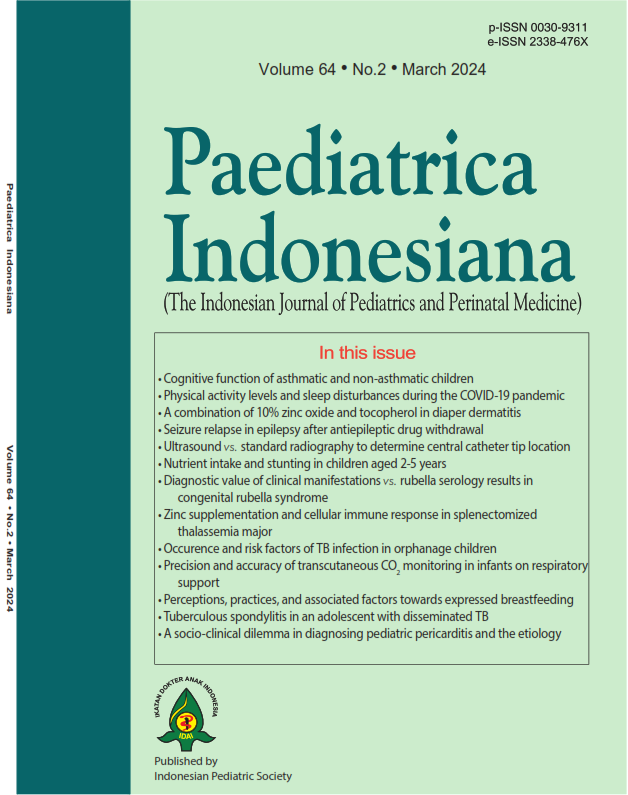Keywords: : congenital rubella syndrome; rubella serology; diagnostic value
AbstractBackground Congenital rubella syndrome (CRS) is the triad of defects/abnormalities in the heart, eyes, and ears, resulting from rubella virus infection, especially in the first trimester of pregnancy. Manifestations of CRS are divided into Group A including: hearing loss, congenital heart disease, cataracts or glaucoma, and pigmentary; Group consisted of purpura, splenomegaly, microcephaly, mental retardation, retinopathy and icteric radiolucent bone disoreder that appears within 24 hours after birth. CRS diagnosis is based on serologic rubella test results. Comprehensive management of CRS is needed to achieve optimal child development. However, not all referral center hospitals in Indonesia have serological rubella examination modalities.
Objective To evaluate the diagnostic value of group A and group B clinical manifestations compared to rubella serology results in the diagnosis of CRS.
Methods This cross-sectional study used secondary data from medical records of pediatric patients with suspected CRS who meet the criteria for groups A and B aged less than 12 months who had been hospitalized at Dr. Zainoel Abidin Regional General Hospital, Banda Aceh, during the three-year study period (2019-2021) which have complete data were included in the study. The IgM serology results were used as diagnostic comparison that performed at the age of less than 12 months.
Results A total of 126 patients met the inclusion criteria. Sixty-five (51.6%) subjects were male, 80 (63.5%) subjects had normal birth weight, and 89 (70.6%) subjects were aged <6 months. The diagnostic sensitivity for groups A, B, as well as A and B clinical manifestations were 100%, 75%, and 100%, respectively. This excellent sensitivity value suggests that the clinical manifestations of groups A and B would be suitable as screening tools because they could “catch” many patients with suspected CRS.
Conclusion The clinical manifestations of group A and group B have excellent diagnostic value as a screening tool for CRS.
References
1. Puspitasari D. Update campak dan sindroma rubela kongenital. In: Alam A, Husada D, Puspitasari D, Kartina L, editors. Updates on Pediatrics Infectious and Tropical Disease. Surabaya: IDAI; 2020. p.79-82.
2. Duszak RS. Congenital rubella syndrome—major review. Optometry - Journal of the American Optometric Association. 2009;80:36-43. DOI: https://doi.org/10.1016/j.optm.2008.03.006
3. Wijana W, Ulfa A. ABR profile in children with congenital rubela syndrome at Hasan Sadikin General Hospital. ORLI. 2019;49:29-34. DOI: https://doi.org/10.32637/orli.v49i1.292
4. Toizumi M, Vo HM, Dang DA, Moriuchi H, Yoshida LM. Clinical manifestations of congenital rubella syndrome: A review of our experience in Vietnam. Vaccine. 2019;37202-9. DOI: https://doi.org/10.1016/j.vaccine.2018.11.046
5. World Health Organization (WHO). Manual for the laboratory- based surveillance of measles, rubela, and congenital rubela syndrome. [cited 2021 February 25]. Available from: https://www.who.int/immunization/newsroom/multimedia/Chapter_1.pdf?ua=1.
6. Oster ME, Riehle-Colarusso T, Correa A. An update on cardiovascular malformations in congenital rubella syndrome. Birth Defects Res A Clin Mol Teratol. 2010;88:1-8. DOI: https://doi.org/10.1002/bdra.20621
7. Gupta AM, Cheema R. Need for heightening awareness of congenital rubella syndrome in the United States. Infect Control Hosp Epidemol. 2019;40:1206-7. DOI: https://doi.org/10.1017/ice.2019.214
8. Song N, Gao Z, Wood JG, Hueston L, Gilbert GL, Maclinyre CR, et al. Current epidemiology of rubella and congenital rubella syndrome in Australia. Vaccine. 2012;30:4073-8. DOI: https://doi.org/10.1016/j.vaccine.2012.04.025
9. Bang NV, Anh NTV, Van VTT, Thai TTH, Thuong NV, Khandaker G, et al. Surveillance of congenital rubella syndrome (CRS) in tertiary care hospitals in Hanoi, Vietnam during a rubella epidemic. Vaccine. 2014;32:7065-9. DOI: https://doi.org/10.1016/j.vaccine.2014.10.087
10. Herini ES, Gunadi, Triono A, Wirastuti F, Iskandar K, Mardin N, et al. Clinical profile of congenital rubella syndrome in Yogyakarta, Indonesia. Pediatr Int. 2018;60:168-72. DOI: https://doi.org/10.1111/ped.13444
11. Herini ES, Triono A, Iskandar K, Prasetyo A, Nugrahanto AP, Gunadi. Congenital rubella syndrome surveillance after measles rubella vaccination introduction in Yogyakarta, Indonesia. Pediatr Infect Dis J. 2021;40:1144-50. DOI: https://doi.org/10.1097/INF.0000000000003290
12. Kementrian Kesehatan Republik Indonesia. Pedoman Surveilans Congenital Rubela Syndrome. [cited 2021 February 25]. Available from: https://www.who.int/docs/default-source/searo/indonesia/non-who-publications/2018-surveillance-guidelines-rubela-syndrome-bahasa.pdf?sfvrsn=d0b7169e_2.
13. Fitriani J, Husna Y. Sindrom rubella kongenital. Jurnal Averrous. 2018;4:1-16. DOI: https://doi.org/10.29103/averrous.v4i1.808
14. Putri ND, Satari HI. Sindrom rubela kongenital: surveilans dan pencegahan. In: Kaswandani N, Alatas FS, Medise BE, Muktriarti D, Andriastuti M, editors. Prosiding Simposium LXXIII Masalah Kesehatan Neonatus Sampai Remaja; 2017 October 22-23; Jakarta. Jakarta: Departemen Ilmu Kesehatan Anak FKUI RSCM;2017.p.53-7.
15. World Health Organization (WHO). Weekly epidemiological record. [cited April 20]. Available from: https://apps.who.int/iris/bitstream/handle/10665/241787/WER8629.PDF.
16. Mekonnen D. Clinically confirmed congenital rubella syndrome: the role of echocardiography. Ethiop J Health Sci. 2017;27:197-201. DOI: https://doi.org/10.4314/ejhs.v27i2.13
17. Kementrian Kesehatan Republik Indonesia. Petunjuk teknis kampanye imunisasi measles rubela (MR). [cited 2021 August 15]. Available from: https://www.who.int/docs/default-source/searo/indonesia/non-who-publications/2017-mr-guidance-immunization-campaign-moh-bahasa.pdf?sfvrsn=4c49454a_2.
18. Dahlan MS. Penelitian diagnostik. Jakarta: Salemba Medika; 2009. p.14-37.
19. Direktorat Surveilans & Karantina Kesehatan, Direktorat Pencegahan & Pengendalian Penyakit, Kementrian Kesehatan Republik Indonesia. Pedoman surveilans congenital rubela syndrome (CRS). Jakarta: Kemenkes RI; 2018.

How to Cite
1.
Sulasmi S, Dimiati H, Andid R, Darussalam D, Thaib T, Anidar A. Diagnostic value of clinical manifestations of Group A and Group B compared with rubella serology results in congenital rubella syndrome. PI [Internet]. 2Apr.2024 [cited 4Jun.2024];64(2):139-4. Available from: https://www.paediatricaindonesiana.org/index.php/paediatrica-indonesiana/article/view/3338
Section
Infection & Tropical Pediatrics
Copyright (c) 2024 Sulasmi Sulasmi, Herlina Dimiati, Rusdi Andid, Dora Darussalam, Teuku Muhammad Thaib, Anidar Anidar

This work is licensed under a Creative Commons Attribution-NonCommercial-ShareAlike 4.0 International License.
Authors who publish with this journal agree to the following terms:
Authors retain copyright and grant the journal right of first publication with the work simultaneously licensed under a Creative Commons Attribution License that allows others to share the work with an acknowledgement of the work's authorship and initial publication in this journal.
Authors are able to enter into separate, additional contractual arrangements for the non-exclusive distribution of the journal's published version of the work (e.g., post it to an institutional repository or publish it in a book), with an acknowledgement of its initial publication in this journal.

This work is licensed under a Creative Commons Attribution-NonCommercial-ShareAlike 4.0 International License.
Received 2023-01-11
Accepted 2024-04-02
Published 2024-04-02
Comments (0)